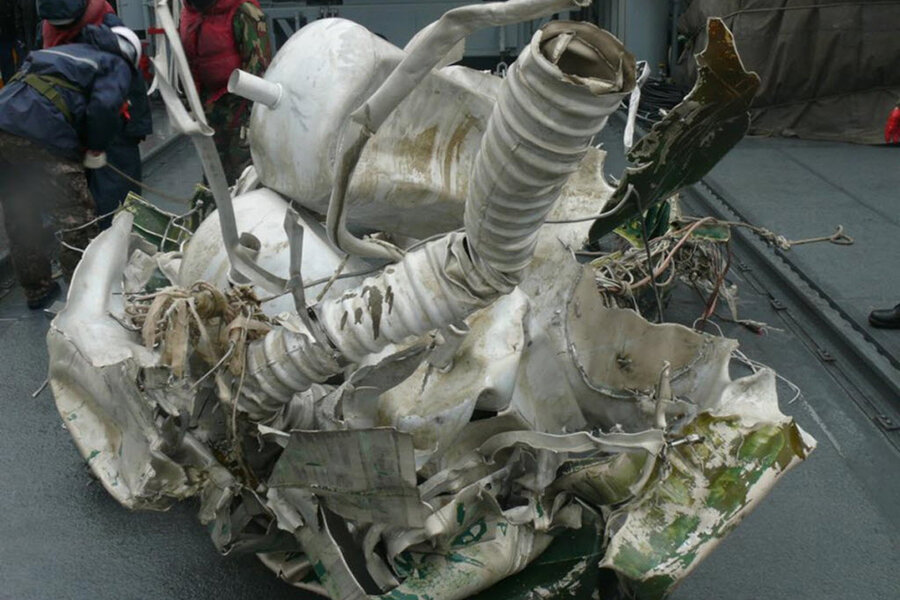South Korea charges North building missile that could reach US
Loading...
| Seoul, South Korea
South Korean defense officials say they have evidence showing a recent North Korean missile launch was to test an intercontinental ballistic missile (ICBM).
South Korean navy divers have recovered more than three tons of debris from the first stage of a missile Korean analysts say was fueled by a type of nitric acid developed in the former Soviet Union over 40 years ago for firing missiles with warheads more than 6,000 miles. The rocket, fired from a pad in northwestern North Korea on December 12, managed to put a small satellite into orbit, but officials offer the discovery of nitric acid as evidence of the real reason why North Korea was anxious to test it.
The defense ministry released a photograph of a truck carrying the most conspicuous piece of the debris – the gleaming white casing for the first stage. The word Unha in Korean lettering, the name of the rocket, was clearly visible.as it was in North Korean pictures of the rocket before the launch.
“Definitely their main purpose is to have the capability of reaching the US west coast,” says Kim Tae-woo, former president of the Korea Institute for National Unification. “North Korea this time proved the capability of their ICBM."
The evidence of the rocket’s mission as a test of an ICBM, according to the defense ministry, was that the main piece of the wreckage was a container for “red
fuming nitric acid” that’s not ordinarily used in missiles for launching satellites.
A member of the team that examined the rocket was quoted by Yonhap, the South Korean news agency, as saying they had found the rocket “was intended for testing ICBM technology rather than developing a space launch vehicle.” He said the team based this conclusion on the fact that “red fuming nitric acid” was used “as an oxidizer” and could “be stored for a long time at normal temperature.”
Navy divers reportedly found still more wreckage on Sunday and are still scouring the seabed of the Yellow Sea off the southwestern coast of South Korea.
The major piece picked up from a depth of 250 feet measured more than 25 feet long and nearly 8 feet in diameter. Mr. Kim, who worked for many years as a senior North Korea analyst at the Korea Institute for Defense Analyses, says the success of North Korean scientists and engineers in launching the rocket “does not mean an immediate threat.”
“They are successful this time,” he says, but “it was just a simple test.” He adds that “their satellite technology is very primitive” – so much so that analysts here believe
North Korea has lost touch with the 200-pound object as it circles the earth.
Mr. Kim is quick to add, however, that putting a satellite into orbit “is not their main target.” Rather, he says, the North Koreans want to develop the technology for firing a warhead a long distance – a highly complicated feat..
The great question is when and how North Korea will test the response of the incoming administrations of both the United States and South Korea. Park Geun-hye, daughter of the long-ruling dictator Park Chung-hee, assassinated by his intelligence chief in 1979, was elected as South Korea’s president last Thursday and is to be inaugurated in February.
“North Korea might be tempted to test John Kerry either by long-range missiles or another nuclear test,” says Lee Chang Choon, a retired South Korean diplomat who
served as ambassador to the International Atomic Energy Agency in Vienna. President Obama has nominated Senator John Kerry to replace Hillary Clinton as secretary of state.
North Korea has conducted two previous underground nuclear tests – in October 2006 and again in May 2009 – soon after test-firing long-range missiles.
Kim Tae-woo agrees with that assessment. “Traditionally North Korea may be preparing to test the will of the second Obama government,” he says. “North Korea definitely wants to test Mr. Kerry.”
North Korea has been celebrating the launch of the rocket – and the satellite – with exuberant displays in Pyongyang. North Korea’s leader Kim Jong-un, reported by Pyongyang’s Korean Central News Agency to have visited the launch site and personally penned the hand-written order to go ahead with the launch, urged more launches at a dinner Friday honoring scientists, engineers and technicians responsible for the launch 11 days ago. KCNA quoted the North Korean leader as urging them to develop “carrier rockets of bigger capacity” in order to put “a variety of more working satellites” into orbit.
The rocket is believed capable of carrying a payload of 1,200 pounds.
South Korea, says Kim Tae-woo, is developing ballistic missiles with a maxium range of 500 miles – enough to reach any target in the North, including the launch site of the Unha. “We can have a much greater deterrence,” he says, “but it takes time.”





